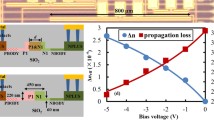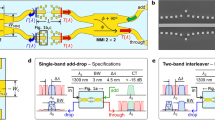Abstract
In this paper, we demonstrated PIN-type and PN-type silicon Bragg gratings using ion implantation technology. This carrier-induced PIN-type silicon Bragg grating can be modulated under a forward bias, and its extinction ratio decreases with the increase of forward bias. The optical 3 dB-bandwidth of 0.45 nm and the ER of 19 dB are achieved on the PN-type Bragg grating. With the carrier injection, the ER modulation is more than 10 dB; with the carrier depletion, the ER modulation is more than 11.5 dB. The electrical modulation speed is fast. An eye-diagram with a data rate of 8 Gbps is measured.
Access provided by Autonomous University of Puebla. Download conference paper PDF
Similar content being viewed by others
Keywords
1 Introduction
Bragg grating-based optical devices have been using widely in optical communication systems, especial the fiber Bragg grating filter [1]. Due to the low index difference in the optical fiber, the Bragg grating length is normally long. On the other hand, it is hard to realize high-speed modulation in the fiber Bragg grating filter. Silicon photonics had become an amazing research hotspot in the last decade because of excellent performances and low cost of silicon materials. Many kinds of silicon Bragg gratings formed by etching process were reported, recently [2, 3]. This kind of silicon Bragg grating structure is permanent, and its reflected wavelength exists in the spectrum once it is formed by etching process. In this paper, we demonstrated both PIN-type and PN-type silicon Bragg gratings using ion implantation technology. This carrier-induced PIN-type silicon Bragg grating can be modulated under a forward bias, and its extinction ratio decreases with the increase of forward bias. However, it is hard to modulate the extinction ratio under a reverse bias because the finger length is hard to change with a reverse bias. The PN-type carrier-induced silicon Bragg grating is using the same ion implantation technology on SOI platform. The extinction ratio of this PN-type silicon Bragg grating can be modulated under both reverse biases and forward biases.
2 Design and Fabrication
The Bragg grating finger is composed of low P and low N implantation, shown in Fig. 1. The instinct Si range is designed between each finger of Bragg grating. The finger pattern is formed by implantation. According to the plasma dispersion effect in silicon, the refractive index of silicon will change with the increase of the ion concentration. The refractive index in P (P−) and N (N−) implantation areas decreases when implantation is processed. On the other hand, the refractive index in the instinct Si range is not changed. So, the Bragg grating is formed by ion implantation. The designed parameters are listed in Table 1.
The carrier-induced Bragg grating was fabricated on an 8-inch silicon-on-insulator (SOI) wafer with 220 nm top Si layer and 2 μm buried oxide. The fabrication process is similar to the PN-type silicon modulator. The carrier concentration near the junction is around 5 × 1017 atoms/cm3 in the finger areas. The AFM image of the dosed silicon waveguide is shown in the left of Fig. 2 after all implantations and annealing. The surface roughness along the dosed silicon waveguide is shown in the right of Fig. 2. The results show that the silicon of less than 1.5 nm is lost in the implantation area. Its contribution to the extinction ratio of reflected wavelength can be negligible.
3 Characterization and Analysis
The measured spectra of this PIN-type/PN-type Bragg grating filters with biases for TE mode is shown in Figs. 3 and 4, respectively. In Fig. 3, the excess loss caused by the implantation is ~1.5 dB and the reflected central wavelength is 1581.80 nm. The extinction ratio is ~14 dB. The measured bandwidth of PIN-type grating is 0.3 nm. Under the different forward biases, the central wavelength shifting rates is −1.35 nm/V. With the forward bias of 1.5 V, the extinction ratio reduces to ~5 dB.
In Fig. 4, the transmission loss is 2.5 dB and the reflected wavelength is 1590.15 nm without any bias. The corresponding extinction ratio is ~19 dB. In consideration of the propagation loss (2.5 dB/cm) of undoped ridge Si waveguide, the excess optical loss from implantation is ~2.0 dB. The extinction ratio modulation of more than 10 dB is realized at the forward voltage of 1.5 V. The high-speed measured result of PN-type Bragg grating is in Fig. 5. When the reverse bias is −20 V, the optical loss of this grating reduces to 1.0 dB from 2.5 dB and an extinction ratio modulation of more than 11.5 dB is realized. The eye diagram of 8 Gbps is measured, shown in Fig. 5.
4 Conclusion
In conclusion, PIN-type and PN-type carrier-induced silicon Bragg gratings formed by ion implantation technology was demonstrated. The extinction ratio of both grating filters is 14 dB and 19 dB, respectively. With the forward bias of 1.5 V, the extinction ratio of PIN-type grating reduces to ~5 dB. Under the reverse bias and forward bias, extinction ratio modulations of PN-type grating are ~11.5 dB and ~10 dB, respectively. The modulation frequency of this carrier-induced is very fast, and the eye diagram of 8 Gpbs data rate is achieved.
References
Tsuda H (2010) Fiber Bragg grating vibration-sensing system, insensitive to Bragg wavelength and employing fiber ring laser. Opt Lett 35:2349–2351
Jiang G et al (2011) Slab-modulated sidewall Bragg grating in silicon-on-insulator ridge wave-guides. IEEE Photon Technol 23:6–8
Honda S et al (2007) Largely-tunable wideband Bragg gratings fabricated on SOI rib waveguides employed by deep-RIE. Electron Lett 43:630–631
Acknowledgements
This work was supported by the National Natural Science Foundation of China (Grant No. 61764008 and No. 61674072), the Opened Fund of the State Key Laboratory of Integrated Optoelectronics (Grant No. IOSKL2017KF11), the Natural Science Foundation of Shanxi Province of China (Grant Nos. 2017JM6075), the Foundation of Shaanxi Provincial Education Department (Grant Nos. 17JK0335) and the Foundation of State Key Laboratory of Functional Materials for Informatics (Grant Nos. SKL201804).
Author information
Authors and Affiliations
Corresponding author
Editor information
Editors and Affiliations
Rights and permissions
Copyright information
© 2021 Springer Nature Singapore Pte Ltd.
About this paper
Cite this paper
Fang, Q., Hu, J., Chen, X., Zhang, Z., Wang, W., Feng, S. (2021). Silicon Photonics Carrier-Induced Waveguide Bragg Grating with Tunable Extinction Ratio. In: Xu, L., Zhou, L. (eds) Proceedings of the 8th International Multidisciplinary Conference on Optofluidics (IMCO 2018). IMCO 2018. Lecture Notes in Electrical Engineering, vol 531. Springer, Singapore. https://doi.org/10.1007/978-981-13-3381-1_15
Download citation
DOI: https://doi.org/10.1007/978-981-13-3381-1_15
Published:
Publisher Name: Springer, Singapore
Print ISBN: 978-981-13-3380-4
Online ISBN: 978-981-13-3381-1
eBook Packages: EngineeringEngineering (R0)









